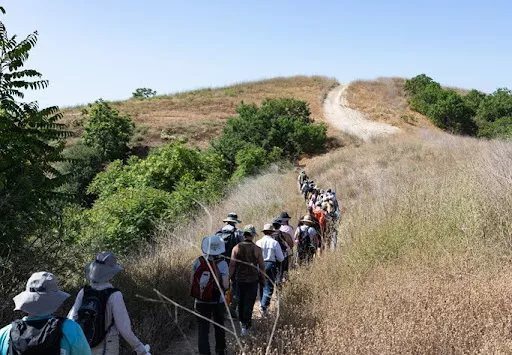
Sierra Club's 30x30 hike at Elephant Hill / Photo by Kelsey Judo
By Barbara Hensleigh
The 30x30 initiative, recognized by the United Nations, the United States and California, proposes to preserve 30% of open space by 2030. The Sierra Club’s 30x30 campaign goals are summed up beautifully in one of its campaign documents: “We envision a world where all people have access to nature, clean air and clean water, where humans respect their interconnectedness to the living environment and treat each other, the earth and all species with humility, care and respect... Working together with communities, we will help secure lasting protections for public lands, waters and wildlife and promote the rights of nature. We will help address the climate and biodiversity crises by keeping fossil fuels in the ground and by better managing forests, deserts and soils to naturally absorb more carbon. We will help protect at least 30 percent of lands and waters by the year 2030, salvaging enough habitat to forestall the extinction crisis and helping to combat the climate crisis. We will work to ensure our communities benefit from time outside and better connections to nature and to our neighbors, fostering healthier individuals and a healthier and more just society overall.”
For Los Angeles, this means a lot. For one thing, 30x30 is not just about the preservation of open space to meet the stated goals, for we need to fight past injustices. Due to redlining and racism, some places like South Los Angeles have little open space. South LA, however, is replete with contaminated land due to heavy industry there. Thus, in addition to preserving open space and the biodiversity in it, 30x30 is also about creating open space through remediation.
Cleaning up contaminated grounds has an “if you build it they will come” philosophy. When land is clean, it is a magnet for birds and wildlife who can rebuild a biodiverse ecosystem. And more than just animals can thrive there – many studies show the beneficial health effects to communities with access to nature.
But in addition to preservation and remediation, our LA’s 30x30 campaign also provides the opportunity to return lands, such as Paradise Hill in East Los Angeles, to our indigenous brothers and sisters.
So how does 30x30 work in Los Angeles County? Your Sierra Club 30x30 leadership team has developed specific criteria to assess land for inclusion in our campaign, based on the principles set forth above. We have around 50 sites on our list, and can add more. Some sites are urban, such as the Los Angeles State Historic Park where we are actively opposing construction of a gondola. Some sites are coastal, such as the Southern LA River Wetlands in Long Beach. And some sites are in the Angeles National Forest. We have chosen places where either the Sierra Club currently has an active campaign to preserve the land, or where we can support communities who are currently fighting to preserve or remediate land. We support all these efforts through lobbying, education, grant writing and more.
As part of our education efforts, we are utilizing the Sierra Club’s incredible hiking structure. On June 16, we held our first 30x30 hike at Elephant Hill, in North East Los Angeles. Elephant Hill, a rare open space revered by the Gabrielino people, has withstood attempts at development, but unfortunately now is subjected to off-road vehicles cutting deep gashes into the hillside. For our outing, we partnered both with the Gabrielino Tribe and with Save Elephant Hill, a grassroots organization that has been working for over a decade to turn the space into a park.
In addition to our work above, we are also a member of Los Angeles County’s Park and Recreation coalition, which is also developing its own 30x30 plan.
We would love to have you join our hardworking leadership team and change the world.
If you wish to volunteer to support the Sierra Club’s 30x30 campaign, email Barbara Hensleigh at barbarajhensleigh@gmail.com